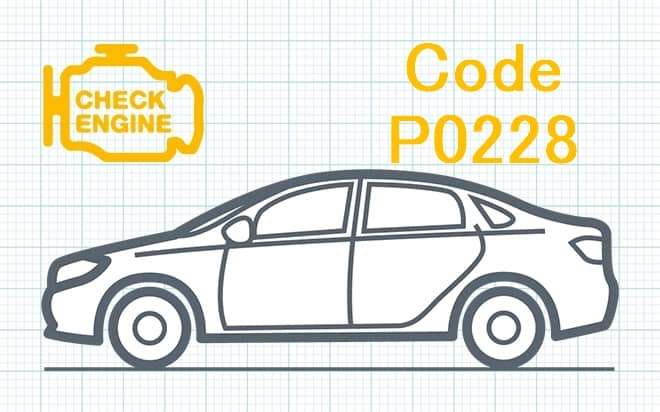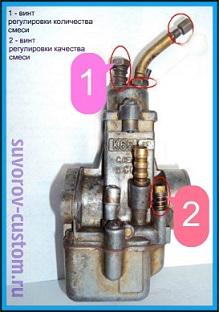
P0228 Throttle Position/Accelerator Pedal Position Sensor “C” Circuit High Input
Content
P0228 – OBD-II Trouble Code Technical Description
Trouble code P0228 indicates a high input signal level of the throttle position/accelerator pedal position sensor “C” circuit.
What does the fault code mean P0228?
Trouble code P0228 indicates a problem with the throttle position sensor (TPS) “C” or its control circuit. In this particular case, this code indicates that the Engine Control Module (ECM) has detected too high voltage on the TPS sensor “C” circuit. This could be due to the sensor itself not working properly or problems with the wiring or connectors connecting the sensor to the ECM.

Possible reasons
Several possible causes for trouble code P0228:
- Throttle Position Sensor (TPS) malfunction: The TPS “C” sensor may be damaged or failed due to wear or other problems, causing the voltage to be read incorrectly.
- Problems with wiring or connectors: Wiring, connections or connectors associated with the TPS “C” sensor may be damaged, broken or corroded, resulting in poor connections or interruptions in signal transmission.
- Incorrect TPS sensor installation or calibration: If the TPS “C” sensor has not been installed or calibrated correctly, it may result in an incorrect voltage reading and therefore an error.
- Problems with the throttle mechanism: Malfunctions or sticking of the throttle mechanism can affect the operation of the TPS sensor “C” as it measures the position of this throttle valve.
- External influences: Moisture, dirt, or other foreign materials entering the TPS “C” sensor or its connector may also cause the sensor to malfunction.
- Problems with the engine control module (ECM): In rare cases, the problem may be due to a malfunction of the ECM itself, which processes signals from the TPS sensor “C” and makes decisions based on these signals.
These causes should be considered when diagnosing the P0228 code to accurately determine the problem and resolve it.
What are the symptoms of a fault code? P0228?
Symptoms for DTC P0228 may include the following:
- Loss of power: The vehicle may experience loss of power when accelerating or while cruising due to incorrect throttle position reading.
- Unstable idle: Engine idling problems may occur, including instability, shaking, or rough operation.
- Acceleration delay: When you press the gas pedal, there may be a delay in the engine's response to changes in load due to improper operation of the throttle position sensor.
- Swimming revs: Engine speed may fluctuate or change erratically when idling or driving due to an incorrect signal from the TPS sensor “C”.
- Speed Limit: In some cases, the vehicle may enter a limited power or limited speed mode to prevent further damage when an error is detected.
- Error on the dashboard: The “Check Engine” light or other related error messages appear on the dashboard.
These symptoms may occur to varying degrees depending on the specific problem and its impact on engine performance.
How to diagnose a fault code P0228?
To diagnose Trouble Code P0228 associated with the Throttle Position Sensor (TPS) “C,” follow these steps:
- Checking Error Codes: Use OBD-II scanner to read error codes from ECU. Make sure the P0228 code is indeed in the error list.
- Visual inspection: Inspect the wiring, connectors, and the TPS “C” itself for damage, corrosion, or breaks.
- Resistance test: Using a multimeter, measure the resistance of the TPS sensor “C” at its connector. The resistance must meet the manufacturer's specifications. If the resistance is outside the acceptable range, the sensor may be faulty.
- Voltage test: Check the voltage at the TPS sensor connector “C” with the ignition on. The voltage must be stable and within the manufacturer's specifications.
- Diagnostics of wiring and connectors: Check wiring and connectors for breaks, corrosion or poor connections. Make sure the wiring is properly connected and not twisted.
- Checking the throttle mechanism: Check if the throttle valve moves freely and is not stuck. Also check that the throttle valve is installed correctly and that there is no mechanical damage.
- Checking other sensors and systems: Check the operation of other engine related sensors such as the accelerator pedal position sensor. Also check the operation of other systems that may affect throttle valve operation.
- ECU check: If all the above steps do not resolve the problem, the problem may be with the ECU itself. In this case, it is recommended to conduct additional diagnostics or consult with a professional auto mechanic.
After diagnosing and identifying the malfunction, it is necessary to begin repairing or replacing parts in accordance with the identified problem.
Diagnostic errors
When diagnosing DTC P0228, the following errors may occur:
- Misinterpretation of symptoms: Some symptoms, such as loss of power or rough idling, may be related to other problems with the fuel injection or ignition system. Misinterpretation of symptoms can lead to misdiagnosis and replacement of unnecessary parts.
- Skip checking other sensors and systems: Code P0228 indicates problems with the throttle position sensor “C”, but the problem may also be related to other sensors or systems, such as the accelerator pedal position sensor or the power system. Skipping other systems may lead to misdiagnosis and missing the cause of the problem.
- Incorrect diagnosis of wiring and connectors: Sometimes the problem may be due to damaged or broken wiring or poor contact in the connectors. Skipping this diagnostic step may result in incorrect identification of the cause of the problem.
- Other components are faulty: TPS “C” sensor malfunction can be caused not only by the sensor itself, but also by other components such as the throttle mechanism or the ECU. Failure or misinterpretation of these components can also lead to diagnostic errors.
- Incorrect TPS sensor calibration or installation: If the TPS “C” sensor has not been installed or calibrated correctly, this may also cause diagnostic errors.
- Using faulty equipment: Faulty or incorrectly configured diagnostic equipment can also lead to incorrect diagnosis.
These errors can lead to misdiagnosis and missing the cause of the problem, so it is important to conduct a thorough diagnosis by following the recommended steps and methods.
How serious is the fault code? P0228?
Trouble code P0228 is quite serious because it indicates problems with the throttle position sensor (TPS) “C” or its control circuit. A malfunction in this system can lead to a number of problems with engine performance and efficiency. Several reasons why this code may be considered serious:
- Loss of power: A malfunctioning TPS “C” sensor may result in a loss of engine power, which may make the vehicle less responsive and less capable of normal driving.
- Unstable idle: Incorrect throttle position reading can result in a rough idle or even a stalled idle, which can cause problems when driving at low speeds or in idle mode.
- Potential security risk: If there is a serious problem with the TPS “C” sensor, the vehicle may lose control or lose power in critical situations, which may lead to an accident or other dangerous situations on the road.
- Increased fuel consumption and emissions: A faulty TPS “C” sensor can cause the fuel injection system to malfunction, which can result in increased fuel consumption and incomplete combustion, which in turn can increase emissions of harmful substances into the environment.
- Speed Limit: In some cases, the vehicle may enter a limited power or limited speed mode to prevent further damage, which may significantly limit the vehicle's ability to drive normally.
So, code P0228 should be considered serious and it is recommended that you have a professional auto mechanic diagnose and fix the problem as soon as possible to avoid further problems and keep your vehicle running safely and efficiently.
What repair will help eliminate the code? P0228?
Resolving trouble code P0228 requires careful diagnosis and possibly replacement or repair of parts, several possible repair actions:
- Replacing the TPS “C” sensor: If the throttle position sensor (TPS) “C” is faulty or shows incorrect readings, it must be replaced with a new or working one.
- Repair or replacement of wiring and connectors: If damage or corrosion is found in the wiring or connectors, they should be replaced or repaired. This will help restore normal signal transmission between the TPS “C” sensor and the Engine Control Module (ECM).
- Setup and Calibration: After replacing the TPS “C” sensor, it must be tuned and calibrated to ensure that it correctly senses the throttle position and sends the appropriate signals to the ECM.
- Additional diagnostics: If the cause of the malfunction is not obvious, additional diagnostics may be required to identify other problems, such as improper operation of the throttle mechanism or problems with the ECM itself.
- Replacement or repair of other components: If the diagnosis reveals other faults related to engine operation or the fuel injection system, they should also be repaired to prevent the reoccurrence of P0228.
Repair steps may vary depending on the specific cause of the problem and its impact on vehicle performance. If you do not have the experience or necessary equipment to perform the repair work, it is recommended that you contact a professional auto mechanic.
P0228 – Brand-specific information
Trouble code P0228 relates to the throttle system and can apply to different makes of vehicles. A few examples of car brands with their definitions for code P0228:
- Ford: Throttle position sensor (TPS) “C” voltage is too high.
- Chevrolet: Throttle Position Sensor (TPS) “C” is out of range.
- Toyota: Throttle Position Sensor (TPS) “C” – signal is out of range.
- Volkswagen: Throttle position sensor (TPS) “C” – high signal.
- Honda: Unacceptable voltage at Throttle Position Sensor (TPS) “C”.
For specific vehicle make and model specifications, please refer to your service documentation or contact the manufacturer.
